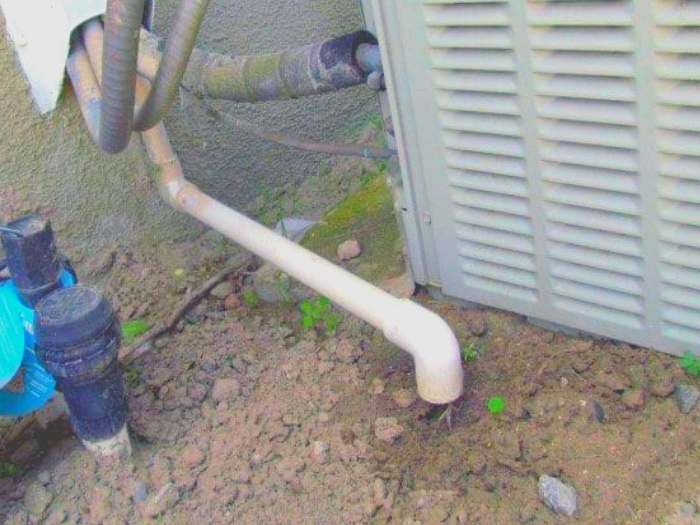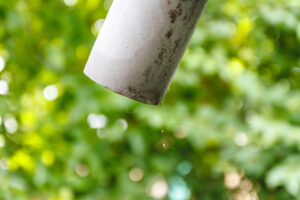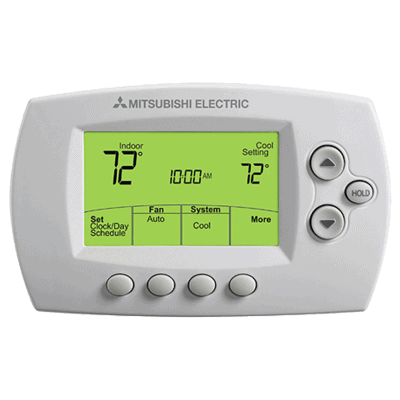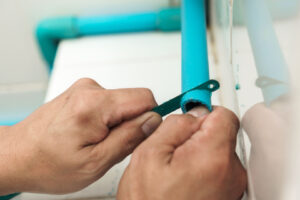Frozen Condensate Line: Recognizing, Preventing & Fixing It

The condensate line, or drain line, on your HVAC system isn’t something the average person knows much about — until they’ve made a heating repair call.
This line is an essential part of the heating and cooling system in your Ocean City, NJ home. However, it’s often out of the way and usually doesn’t cause a problem.
Occasionally, there’s an issue, and in the winter, the most common problem is water freezing up inside it.
When this happens, your system can’t operate correctly. We’ll get into the specifics in a moment. But, the good news is that there’s a good chance you can fix the problem yourself!
This article will give you a crash course on these drain lines and what they do. Then we’ll tell you how to find it, troubleshoot, and hopefully handle it without calling anyone.
Finally, we’ll give you some tips on preventing it from happening again.
But, if you feel unsafe doing something or aren’t sure what to do, don’t take any chances! Your HVAC system is intricate and expensive. You don’t want to make anything worse.
Instead, call or email Broadley’s today for heating, cooling, or plumbing concerns in your Ocean City, NJ home.
What Is A Condensate Line?
The condensate line removes the moisture collected on the evaporator coil in your furnace or central air conditioner. As the heat transfer process causes water vapor to turn back into liquid, that water has to get out of the system. So, it drains out through the condensate line.
Take a look at the indoor part of your HVAC system. You’ll likely see a narrow PVC tube coming out of it. It often drains outside, but occasionally you’ll see them lead into a laundry sink or a pan.
They’re easy to miss since they’re small, and water normally drips out slowly — it’s not like you’ll notice a steady stream or anything.
But, of course, if it’s frozen, you won’t notice any liquid coming out. And, that’s what we’re covering today.
How To Tell You Have A Frozen Condensate Line
Your furnace or AC will switch off and not turn back on if the condensate line becomes frozen. When this happens, water in the pipe turns to ice and blocks any more water from getting out.
Unfortunately, many other errors or problems can cause your furnace to stop working. So, you’ll have to do some troubleshooting to see what the problem is.
In this case, we’ll walk you through a few other common problems. Then we’ll get to the topic at hand.
Quick Furnace Troubleshooting
Start by checking the thermostat. Make sure the batteries have power, and the unit is set to heat. Low energy can result in a bad reading or malfunction. Or, someone accidentally changing a setting can cause your system to turn off.
Check your circuit breaker, too. Make sure nothing’s tripped. Also, ensure the furnace is turned on.
Finally, pull out the air filter. If it’s completely covered in dirt, then it could be clogging the system. Air can’t get through, which results in warmth backing up into the system and overheating the inner components.
That’s about as far as you can go without calling in a heating repair pro to run diagnostics or check the fans, blowers, electrical components, and the like.
But, your last move is to check the drain line. Some furnaces or boilers will give you an error code indicating that this is the problem. If yours doesn’t have that feature, it’s time for a visual inspection.
Is Your Drain Line Frozen?
Start by locating that narrow PVC pipe leading out from the furnace. Follow it all the way to where it opens up.
As we mentioned, it’s usually outside, but occasionally it drains to a pan or sink. If it’s wholly located indoors, it’s not likely that there’s any ice in it.
If it leads outside, this could be the problem. And it will be easy to spot.
Find the end of the line. Look for ice at the opening, or shine a light inside to see if you spot a blockage. You can also feel the pipe itself to note if it’s especially cold.
If you find evidence that it’s blocked up by ice, you can likely fix it yourself.
Fixing A Frozen Condensate Line
If you can thaw the line, you’ve fixed the problem. And, there’s a good chance that all you need to do the job is some hot water. You need to warm the section of the piping where the ice is located. Once it melts, the blockage is gone. But, you need to be careful doing this for a few reasons.
First, there’s always the chance that you can burn yourself with hot water. And, if you’re outside in the cold when it happens, it’s going to hurt even more than usual!
And, you risk damaging the drain line if you do it wrong. But this should be easy to avoid.
Start by boiling some water. You can fill a tea kettle or use even a little more than that. But, what’s important is to let it cool back down a little.
Remember, that piping is likely just PVC. It’s sturdy, but it’s not made to stand up to temperatures that extreme. Plus, it’s especially cold at the moment. Too drastic of a temperature change can cause damage.
And, of course, you’re more likely to burn yourself if the water’s too hot. So, let it cool down a bit first.
In the meantime, wrap the piping with some insulation if you have any available. The problem should be outside, so cover the exterior portion to preserve heat.
You can also do the same inside, where the line exits through a wall. The more warmth you can retain, the better.
Then, once the water’s ready, remove the insulation outside. Then, pour the warm — not boiling! — water on the line, slow and steady. You can wipe it dry, replace the insulation, and repeat this process if necessary.
Prevent your Condensate Line from Freezing
You can prevent the condensate line from freezing (again!) by prepping the piping outside your home. If it’s sticking out more than a few inches, have a professional shorten the pipe. Also, add permanent insulation to keep it warm.
We can’t stress this enough: Do NOT heat out there with a saw or power tool and go all Paul Bunyan on the PVC pipe.
Yes, it’s a straightforward job. But, also yes: There’s a good chance you can damage the line. Call for heating repair from your trusted HVAC contractor to handle it.
And, when you call your contractor, they may also be able to take a few extra steps. If you’ve had a problem with the line freezing before, there’s a chance they can bundle other exterior lines along with it.
By reducing the exposed surface area, you can conserve heat. And, if there’s anything attached to your dryer, for instance, they may be able to use that warmth as well.
Meanwhile, you can certainly pick up some inexpensive outdoor pipe insulation and wrap the tubing yourself.
Furnace Repair in Ocean City, NJ
If you suspect a frozen drain line but can’t find the blockage or have any other problems with the HVAC or plumbing in your Ocean City, NJ home, call or email Broadley’s today for furnace repair.
We’ve served Cape May and Atlantic counties for nearly a century. You can rely on us to get you up and running as soon as possible.





